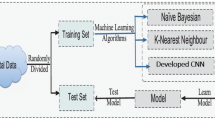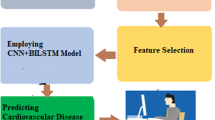Abstract
In modern society, the number of chronic patients is increasing due to various causes, such as drinking, smoking, unhealthy lifestyles, and stress. Chronic diseases must be managed with constant care, but may get worse from various factors. With the development of information technology, healthcare technologies using health big data, machine learning, and reinforcement learning are attracting attention. Using these technologies, it is possible to predict potential diseases that may occur in the future by using data learning and clustering of similar data. To predict the potential for disease, we should research various models based on the convolutional neural network (CNN), which can identify knowledge objects from unstructured data such as medical data. However, the fully connected network structure of the CNN generally uses a large amount of memory. Another problem is that complexity increases with the number of layers. This causes the overfitting problem, which increases error. To solve this problem, this paper proposes a CNN-based health model using knowledge mining of influencing factors. The proposed method uses hidden layers of a double-layer structure within the CNN structure. The double-layer structure has the optimal conditions for classification, compared with a single layer that allows the AND/OR operations. First, the amount of data used is reduced by extracting influencing factors through multivariate analysis, and these influencing factors are used as input data. Significant influencing factors are extracted from the first hidden layer using the significance level. This improves accuracy, because it extracts data required for analysis. Common influencing factors appropriate for significance levels are extracted. Common influencing factors refer to correlated factors that can affect each other. In the second hidden layer, the correlations between influencing factors are discovered through a correlation coefficient, and they are classified into positive and negative factors. Furthermore, associated rules are discovered through knowledge mining from among the classified influencing factors. They are subdivided into influencing factors like obesity, high blood pressure, and diabetes through the rules of the discovered influencing factors. For performance evaluation, the root mean square error (RMSE) of the CNN model is evaluated according to the application of knowledge mining to the influencing factors. The evaluation of accuracy, computational load, complexity, and learning rate showed better results, compared with the existing method. Through the proposed health model, knowledge about the associations of various factors is derived.







Similar content being viewed by others
References
Anya O, Tawfik H (2017) Designing for practice-based context-awareness in ubiquitous E-health environments. Comput Electr Eng 61:312–326
Yoo H, Chung K (2017) PHR based diabetes index service model using life behavior analysis. Wirel Pers Commun 93(1):161–174
Jung H, Chung K (2016) Knowledge-based dietary nutrition recommendation for obese management. Inf Technol Manag 17(1):29–42
Swapna G, Vinayakumar R, Soman K (2018) Diabetes detection using deep learning algorithms. ICT Express 4(4):243–246
Månsn L, Zhang Y, Fredrik K (2018) Robust abdominal organ segmentation using regional convolutional neural networks. Appl Soft Comput 70:465–471
Stuart R, Peter N (2010) Artificial intelligence: a modern approach. Third Edition. Pearson Education, London, p 733–736
Cheng S, Pun CM (2018) Multi-scale hierarchical recurrent neural networks for hyperspectral image classification. Neuro Computing 294:82–93
Ciocca G, Napoletano P, Schettini R (2018) CNN-based features for retrieval and classification of food images. Comput Vis Image Underst 176-177:70–77
Swapna G, Soman K, Vinayakumar R (2018) Automated detection of diabetes using CNN and CNN-LSTM network and heart rate signals. Prog Comput Sci 132:1253–1262
Sajjad M, Khan S, Muhammad K, Wu W, Ullah A, Baik S (2018) Multi-grade brain tumor classification using deep CNN with extensive data augmentation. J Comput Sci 30:174–182. https://doi.org/10.1016/j.jocs.2018.12.003
Liu X, Hou F, Qin H, Hao A (2018) Multi-view multi-scale CNNs for lung nodule type classification from CT images. Pattern Recogn 77:262–275
National Health and Nutrition Examination Survey, http://knhanes.cdc.go.kr/. Accessed 16 Jan 2019
Kang J, Shin SJ, Park J, Bang S (2018) Hierarchically penalized quantile regression with multiple responses. J Korean Stat Soc 47(4):471–481
Fernández J (2018) Time-localized wavelet multiple regression and correlation. Physica A 492:1226–1238
Xuanxua Z (2018) Multivariate linear regression analysis on online image study for IoT. Cogn Syst Res 52:312–316
Mu Y, Liu X, Wang L (2018) A Pearson’s correlation coefficient based decision tree and its parallel implementation. Inf Sci 435:40–58
Deshmukh J, Bhosle U (2016) Image mining using association rule for medical image dataset. Procedia Computer Science 85:117–124
Xiang Y, Zhang G, Gu S, Cai J (2018) Online multi-layer dictionary pair learning for visual classification. Expert Syst Appl 105:174–182
Singh S, Garg R, Mishra P (2018) Performance optimization of MapReduce-based Apriori algorithm on Hadoop cluster. Computers & Electrical Engineering 67:348–364
Djenouri Y, Comuzzi M (2017) Combining Apriori heuristic and bio-inspired algorithms for solving the frequent itemsets mining problem. Inf Sci 420:1–15
Kim JC, Chung K (2018) Mining health-risk factors using PHR similarity in a hybrid P2P network. Peer-to-Peer Networking and Applications 11(6):1278–1287
Yoo H, Chung K (2018) Heart rate variability based stress index service model using bio-sensor. Clust Comput 21(1):1139–1149
Oh SY, Chung K (2018) Performance evaluation of silence-feature normalization model using cepstrum features of noise signals. Wirel Pers Commun 98(4):3287–3297
Kim JC, Chung K (2019) Associative feature information extraction using text mining from health big data. Wirel Pers Commun 105(2):691–707
Chung K, Yoo H, Choe D, Jung H (2019) Blockchain network based topic mining process for cognitive manufacturing. Wirel Pers Commun 105(2):583–597
IBM Watson Studio, https://www.ibm.com/cloud/watson-studio/. Accessed 14 Jar 2019
Weka, https://www.cs.waikato.ac.nz/. Accessed 16 Apr 2018
KCDC (2018) Korea Centers for Disease Control (online), http://www.cdc.go.kr/CDC/eng. Accessed 16 Apr 2018
KNHNES (2016) 7th Korean National Health and Nutrition Examinations Survey (KNHANES VII-1). Korea Centers for Disease Control and Prevention
Mentaschi L, Besio G, Cassola F, Mazzino A (2013) Problems in RMSE-based wave model validations. Ocean Model 72:53–58
Xu Q, Zhang M, Gu Z, Pan G (2019) Overfitting remedy by sparsifying regularization on fully-connected layers of CNNs. Neurocomputing 328:69–74
Baek JW, Kim JC, Chun J, Chung K (2019) Hybrid clustering based health decision-making for improving dietary habits. Technol Health Care. https://doi.org/10.3233/THC-191730
Choi SY, Chung K (2019) Knowledge Process of Health Big Data using MapReduce-based Associative Mining. Pers Ubiquit Comput. https://doi.org/10.1007/s00779-019-01230-3
Jung H, Chung K (2019) Knowledge-based Dynamic Cluster Model for Healthcare Management using a Convolutional Neural Network. Inf Technol Manag. https://doi.org/10.1007/s10799-019-00304-1
Funding
This work was supported by the National Research Foundation of Korea(NRF) grant funded by the Korea government (MSIT) (No. 2019R1F1A1058651).
Author information
Authors and Affiliations
Corresponding author
Additional information
Publisher’s note
Springer Nature remains neutral with regard to jurisdictional claims in published maps and institutional affiliations.
Rights and permissions
About this article
Cite this article
Baek, JW., Chung, K. CNN-based health model using knowledge mining of influencing factors. Pers Ubiquit Comput 26, 221–231 (2022). https://doi.org/10.1007/s00779-019-01300-6
Received:
Accepted:
Published:
Issue Date:
DOI: https://doi.org/10.1007/s00779-019-01300-6




